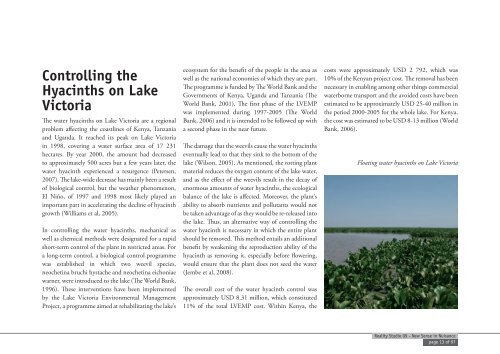You also want an ePaper? Increase the reach of your titles
YUMPU automatically turns print PDFs into web optimized ePapers that Google loves.
Controll<strong>in</strong>g the<br />
Hyac<strong>in</strong>ths on Lake<br />
Victoria<br />
The water hyac<strong>in</strong>ths on Lake Victoria are a regional<br />
problem affect<strong>in</strong>g the coastl<strong>in</strong>es of Kenya, Tanzania<br />
and Uganda. It reached its peak on Lake Victoria<br />
<strong>in</strong> 1998, cover<strong>in</strong>g a water surface area of 17 231<br />
hectares. By year 2000, the amount had decreased<br />
to approximately 500 acres but a few years later, the<br />
water hyac<strong>in</strong>th experienced a resurgence (Petersen,<br />
2007). The lake-wide decrease has ma<strong>in</strong>ly been a result<br />
of biological control, but the weather phenomenon,<br />
El Niño, of 1997 and 1998 most likely played an<br />
important part <strong>in</strong> accelerat<strong>in</strong>g the decl<strong>in</strong>e of hyac<strong>in</strong>th<br />
growth (Williams et al, 2005).<br />
In controll<strong>in</strong>g the water hyac<strong>in</strong>ths, mechanical as<br />
well as chemical methods were designated for a rapid<br />
short-term control of the plant <strong>in</strong> restricted areas. For<br />
a long-term control, a biological control programme<br />
was established <strong>in</strong> which two weevil species,<br />
neochet<strong>in</strong>a bruchi hystache and neochet<strong>in</strong>a eichoniae<br />
warner, were <strong>in</strong>troduced to the lake (The World Bank,<br />
1996). These <strong>in</strong>terventions have been implemented<br />
by the Lake Victoria Environmental Management<br />
Project, a programme aimed at rehabilitat<strong>in</strong>g the lake’s<br />
ecosystem for the benefit of the people <strong>in</strong> the area as<br />
well as the national economies of which they are part.<br />
The programme is funded by The World Bank and the<br />
Governments of Kenya, Uganda and Tanzania (The<br />
World Bank, 2001). The first phase of the LVEMP<br />
was implemented dur<strong>in</strong>g 1997-2005 (The World<br />
Bank, 2006) and it is <strong>in</strong>tended to be followed up with<br />
a second phase <strong>in</strong> the near future.<br />
The damage that the weevils cause the water hyac<strong>in</strong>ths<br />
eventually lead to that they s<strong>in</strong>k to the bottom of the<br />
lake (Wilson, 2005). As mentioned, the rott<strong>in</strong>g plant<br />
material reduces the oxygen content of the lake water,<br />
and as the effect of the weevils result <strong>in</strong> the decay of<br />
enormous amounts of water hyac<strong>in</strong>ths, the ecological<br />
balance of the lake is affected. Moreover, the plant’s<br />
ability to absorb nutrients and pollutants would not<br />
be taken advantage of as they would be re-released <strong>in</strong>to<br />
the lake. Thus, an alternative way of controll<strong>in</strong>g the<br />
water hyac<strong>in</strong>th is necessary <strong>in</strong> which the entire plant<br />
should be removed. This method entails an additional<br />
benefit by weaken<strong>in</strong>g the reproduction ability of the<br />
hyac<strong>in</strong>th as remov<strong>in</strong>g it, especially before flower<strong>in</strong>g,<br />
would ensure that the plant does not seed the water<br />
(Jembe et al, 2008).<br />
The overall cost of the water hyac<strong>in</strong>th control was<br />
approximately USD 8.31 million, which constituted<br />
11% of the total LVEMP cost. With<strong>in</strong> Kenya, the<br />
costs were approximately USD 2 792, which was<br />
10% of the Kenyan project cost. The removal has been<br />
necessary <strong>in</strong> enabl<strong>in</strong>g among other th<strong>in</strong>gs commercial<br />
waterborne transport and the avoided costs have been<br />
estimated to be approximately USD 25-40 million <strong>in</strong><br />
the period 2000-2005 for the whole lake. For Kenya,<br />
the cost was estimated to be USD 8-13 million (World<br />
Bank, 2006).<br />
Float<strong>in</strong>g water hyac<strong>in</strong>ths on Lake Victoria<br />
Reality Studio 09 - <strong>New</strong> <strong>Sense</strong> <strong>in</strong> <strong>Nuisance</strong><br />
page 13 of 97


